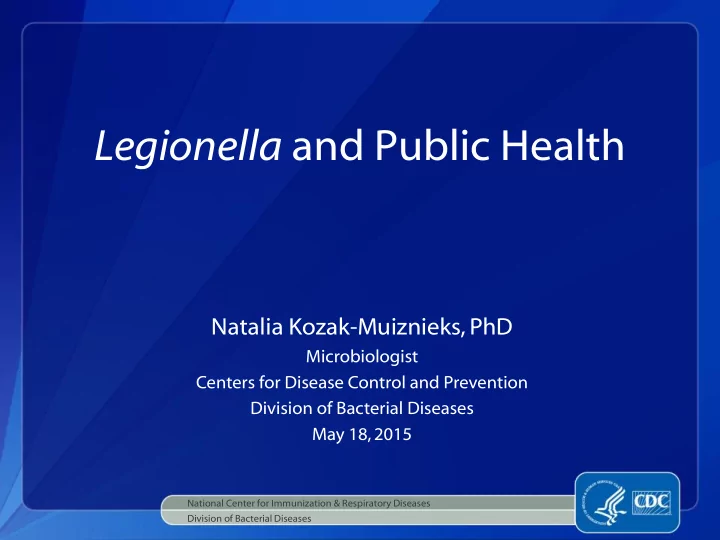

Legionella and Public Health Natalia Kozak-Muiznieks, PhD Microbiologist Centers for Disease Control and Prevention Division of Bacterial Diseases May 18, 2015 National Center for Immunization & Respiratory Diseases Division of Bacterial Diseases
Legionella Holland/Özel , Robert Koch-Institut
Temperature range of Legionella 35 42 45 55 25 Celsius Fahrenheit 77 95 108 113 131 Dormant Death Growth
Legionella are biofilm associated free-floating bacteria secreted slime surface biofilm-associated bacteria
Disease Transmission Water Supplies Host Amplification Aerosolization Transmission
Incidence of Legionellosis — United States, 1998-2011* 1.6 Incidence per 100,000 pop. 1.4 1.2 1 0.8 0.6 0.4 0.2 0 1998 1999 2000 2001 2002 2003 2004 2005 2006 2007 2008 2009 2010 2011 Year • *National Notifiable Disease Surveillance System • 2013: provisional report until Sept 2013
Average Annual Rates of Reported Legionellosis Cases per 100,000 Population, NNDSS, 2000-2009 < 0.50 0.50 - 1.00 1.01 - 1.50 1.51 - 2.00 2.01 - 2.50 2.51 - 3.00 Note: Alaska and Hawaii are part of the Pacific Reporting Area
What is an outbreak? An outbreak is 2+ cases within 1 year Exception: hospitals 1 confirmed case or 2 suspect Responses: Consultation Collaboration Epi-Aid
Epidemiology Patient Questionnaires Case definition Case finding Initial recommendations
What is the source? 6 4 5 3 Number of cases 4 Case Count 3 2 2 1 1 0 8/31/2013 9/30/2013 0 Symptom Onset Date Illness onset
Legionella Environmental Assessment Facility characteristics Outside water supply Premise plumbing system Hot tubs and whirlpool spas Cooling towers Recent or ongoing major constructions
Commonly Sampled Locations Central distribution point (hot water heater) Rooms where patients were housed (potable) Aerosol generating devices (cooling towers, humidifiers, etc.) Medical devices (hydrotherapy pools, CPAP machines, etc.) Recreational and decorative features (whirlpool spas, fountains, etc.)
Sample Processing, Legionella Isolation and Characterization 5-8 hours - Initial sample processing Up to 7 days - Incubation Up to 2 days - Confirming Legionella isolates to genus level • 3- 4 days - Getting single colony isolates • Up to 2 weeks - Identification species, serogroups and genotypes BCYE BCYE without L-cysteine
Genus Legionella 60 species of Legionellae > 90% of the isolates associated with 17 serogroups of Legionnaires’ disease - L. pneumophila L. pneumophila 79% of cases are due to L. Lp6, Lp5, Lp8 are also pneumophila serogroup 1 (Lp1) frequent “offenders” majority of Lp1 clinical MAb panel contains 7 isolates reacts with monoclonal MAb2 antibodies Virulent genotypes There are > 2000 sequence types of L. pneumophila, yet only 16 STs are responsible for the majority of sporadic LD cases
Recommendations and Conclusions • Water restrictions • Notify residents • Begin (or continue) active surveillance • Emergency remediation (heat flush and/or hyperchlorination) • Post remediation sampling 2X monthly for 3 months • Post remediation sampling 1X monthly for additional 3 months • Strive for eradication
Knowledge Gaps • Better methods of acute remediation • Best methods for long term control – situational? • How to evaluate emerging technologies? • Safe level of Legionella ?
Case Studies
VA Hospital Background: High rate LD testing Routine environmental testing Cu/Ag disinfection Investigation Aug: 2 clinical isolates Oct: 1 environmental isolate Since 2010: 5 confirmed, 21 suspect Similar to 1982 environmental Conclusions: Long term persistence Low suspicion
Las Vegas Condominiums Background: 2001: 3 travel cases 2002: chlorine dioxide 2008: 4 travel cases Investigation 16 confirmed, 19 probable Transmission through showers ST35 in 2001, 2002, & 2008 ST35: one of the “bad” STs Conclusions: Long term persistence Increase temp & ClO 2 • Silk BJ et al. Epidemiol Infect. 2012 Nov;140(11):1993-2002. Epub 2012 Jan 4.
GA Resort Background: 2007 – 2014 six LD cases Stayed in 6 different rooms or chalets Investigation: Water supplied by 5 wells w/out disinfectant or filtration Outdoor spas inside rooms Staff couldn’t describe water system in reasonable details 35% sites positive for Lp1 ST36 Conclusion: Importance of residual disinfection
Thank you! Natalia Kozak-Muiznieks Centers for Disease Control and Prevention 1600 Clifton Rd NE MS G03 Atlanta, GA 30333 Phone (404) 639-2305 For more information please contact Centers for Disease Control and Prevention 1600 Clifton Road NE, Atlanta, GA 30333 Telephone, 1-800-CDC-INFO (232-4636)/TTY: 1-888-232-6348 E-mail: cdcinfo@cdc.gov Web: www.cdc.gov The findings and conclusions in this report are those of the authors and do not necessarily represent the official position of the Centers for Disease Control and Prevention. National Center for Immunization & Respiratory Diseases Division of Bacterial Diseases
Recommend
More recommend